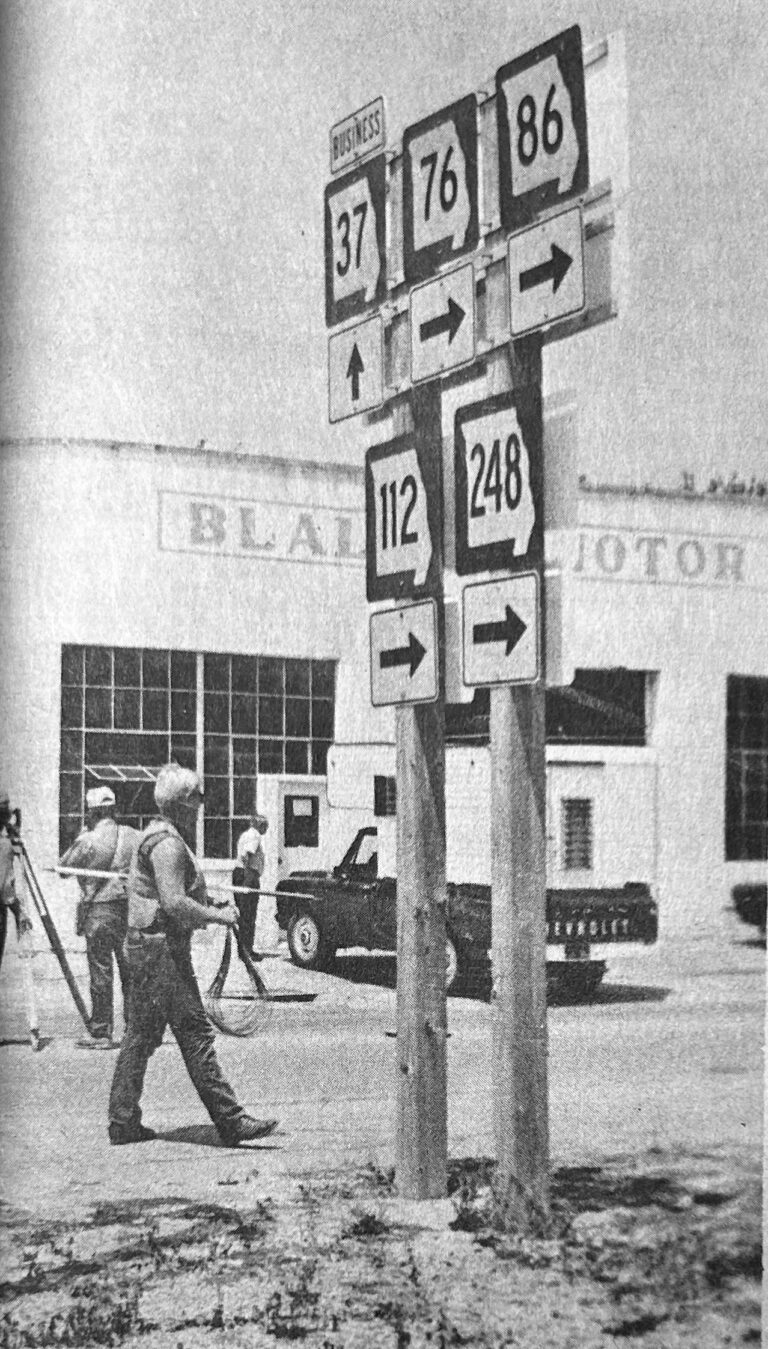Through the Years, July 23

50 years ago
July 30, 1975
— MISS WADE’S ACTION SAVED DROWNING YOUTH
Quick and effective action by Miss Karen Wade, operator of the Cassville swimming pool, has been credited with saving the life of a 13-year-old Purdy youth Friday. Bobby Ray, son of Mr. and Mrs. Thomas Ray nearly drowned while swimming at the pool. Miss Wade removed the youth from the pool and restored breathing by mouth-to-mouth resuscitation. Ray was treated at South Barry County Hospital and later transferred to St. John’s in Springfield. The Purdy youth was apparently hit by another swimmer entering the water and knocked unconscious. Miss Wade, a fully qualified instructor and excellent swimmer, used all her training in saving the youth’s life. Ray was listed in satisfactory condition Sunday in the Springfield hospital. Miss Wade, a junior at Culver Stockton College this year, is a daughter of Mr. and Mrs. Clell Wade of Quincy, Ill., who have a summer home here. She is a granddaughter of Mr. and Mrs. Vernon Chumbley of Cassville.
— INTERSECTION PLAN NEAR COMPLETION FOR MAIN ST.
Missouri Highway Department survey crews have completed final plan preparation work on two intersection improvements in Cassville. Wilbur Stegner, district engineer, says the survey was to make final determination of curb locations. Within the next few weeks, department personnel will be here to lay out the design of proposed improvements in formal sessions with city officials and property owners in the south part of town. Costing an estimated $235,100, the project was originally programmed for 1977. Stegner said traffic flow patterns that continue increasing at the two intersections make it highly possible the program would be movedup as a priority project. While department engineers in Jefferson City must approve final designs of the intersections, Stegner said the Chamber of Commerce urged project here would be practically fully determined When the sessions are scheduled. Intersections included involve Main Street, Highway 48-76-86 and 112. Presently carrying in excess of 905 vehicles an hour during peak periods, the major intersection between Fourth and Fifth streets on Main would be signalized in the project. The Unction has recorded in excess of 7,480 cars in a 12 hour period. Another intersection, Sales Barn Road, that also leads to new FASCO Industries plant, would be curbed and traffic routes re-directed for Petter control. This junction would also have initial wiring installed should a traffic signal become necessary in the future. An additional feature of the redesign would be removal of the pie-area and parking on Main between Sixth and Fifth to allow through traffic and left turn lanes being installed. This would be in the area of First National Bank and Cassville-Branch of Monett Savings and Loan properties. The city of Cassville has previously indicated cooperating with the department in the project which would remove extreme traffic congestion at the crowded intersection. Several months ago, Stegner and Don Hole, traffic survey director for the district, presented initial plans at a C of C sponsored session that also included owners of businesses in the area of the two junctions. The district engineer said that wherever possible for safety and practical operation of the improvements, property owner wishes would be considered. This factor is what necessitated the additional survey for marking of traffic control curbs that would be placed in the vicinity of the improvement. Chamber of Commerce interests in the project are directed by co-chairmen Carter Koon and Truman Baker.
40 years ago
July 31, 1985
— MCGRATHS AND SCHELLS ACQUIRE NEW PROPERTIES
Two major business transactions were reported in Cassville this week. Included was the purchase of the business properties of Mr. and Mrs. Ernest German being purchased by Mr. and Mrs. Ron McGrath. The property transaction involves a number of business locations in the south part of Cassville. Finished last week was a transfer of Jackson Trailer Park on County Farm Road to Mr. and Mrs. Billy Schell, from former owners and developers, Mr. and Mrs. Leon Jackson. Mr. and Mrs. McGrath, operators of Montgomery Wards in Cassville, bought the long-time German family properties, which houses eight businesses or offices. The properties are located on the south side of the highway intersection in mid-Cassville. The McGraths said there were no changes contemplated in the property. Their purchase was for investment purposes, according to McGrath. Mr. and Mrs. Schell, in purchasing the 17-acre trailer development, said the 53-unit facility would be managed by their daughter and son-inlaw, Mr. and Mrs. James Stephens.
— TOWN VALUATIONS INCREASE 2.5 TIMES FOR 1985
Tax totals in seven Barry County towns show a grand increase of over 2.5 times under reassessment, according to June Smith, deputy, in the office of assessor Glen Nicoll. Mrs. Smith completed running totals for the seven towns Tuesday afternoon. Totals came out of the Barry County computer and can be provided municipal governments for completion of tax levy rollbacks, required under the Missouri program for tax equalization. Mrs. Smith said the grand totals of city valuations amounted to $18,464,193 last year, but jumped to $45,962,262 for the 1985 valuations. Individual municipal figures, with 1984 listed first and 1985 second, include the following: Monett, $11,446,606 and $27,288,340.
Seligman, $398,376 and $995,355.
Washburn, $237,976 and $690,035.
Wheaton, $667,459 and $1,613,341 Purdy, $1,039,986 and $2,549,098.
Exeter, $634,885 and $1,618,484.
Cassville, $4,039,005 and $11,207,609.
Mrs. Smith said the 1984 totals were combined for real, personal and merchants and manufacturing. The 1985 totals list real and personal, with merchant and manufacturing dropped in favor of a commercial division. The assessor’s office said municipal governments could obtain print-outs of tax lists for their individual purpose through arrangements with the county administrative.
30 years ago
July 26, 1995
— COMMISSION PLACES JAIL AT TOP OF COUNTY NEEDS
Barry County commissioners will begin plans this month to find a more permanent solution to overcrowded conditions at the Barry County Jail. Presiding Commissioner Cherry Warren said that the jail is the county’s top priority. After Sheriff Ralph Hendrix presented a report on jail conditions to the commission two weeks ago, the commissioners responded by approving Hendrix’s request to farm out prisoners to neighboring jails. The commissioners said that housing prisoners in other jails is a “stop-gap measure.” They agreed that in the long run the county must be able to handle its own prisoners. “As long as we maintain a court here, we need to maintain a jail,” said Red Edens, southern commissioner. Warren said that in the next month, the commission would be contacting an architect to determine if adding on to the existing jail would be feasible. The addition would add more jail cells and possibly more office space. Warren and Edens said that an addition to the jail would be financed through existing funds. “We think we will have funds available for the project,” Warren said. “The county is in a strong financial position. We have already set aside $56,000 for capital improvements in this year’s bud-get. We can do the things we need without a tax increase. In addition to capital improvement funds, the county commission may be able to use some of the $200,000 it saved when it decided not to install central heat and air in the courthouse. “We decided there were more pressing needs in the county,” Warren said. Increased revenue from county sales tax could also be added to available funding. Over the last three years, the budget for the jail has increased substantially. In 1993, the jail’s budget was $60,213. In 1994, it stood at $151,965, and this year, the jail is being operated on a $193,177 budget. Once the county’s jail needs are addressed, Warren said the commission will begin tackling the county’s next priority – building a second Associate Circuit Courtroom. The commission expects population numbers in Barry County to reach over 30,000 by the 2000 census. Under state law, counties that have more than 30,000 residents must have two associate circuit courtrooms. “This is something we’re aware of and will plan for down the road,” Warren said. No specific plans have been made by the commission concerning this issue.
— NUMBER OF POOR LIVING IN COUNTY HAS INCREASED
As Barry County’s population as grown, so has the number of people living in poverty. There are in estimated 4,512 people in the county who live below the poverty line. This total marks a 21 percent increase over the last 15 years, according to census figures. This increase in poverty means that the work of local social service agencies, like the Ozarks Area Community Action Corporation, is more important than ever. Gail Reed, supervisor at DACAC’s Barry County Neighborhood Center, said that helping impoverished families find solutions to their problems is the driving force behind the services they offer. The Barry County Neighborhood Center is located at 211 E. Fifth St. and has been serving this area for 27 years. During the past year, over 1,161 people received help at the center.
Anyone whose income is below poverty guidelines is eligible for assistance. The poverty line for a household of two is set at $10,030 a year. For a household of four, the poverty line is $15,150. Eligible families can receive free assistance from the Neighborhood Center in the areas listed below.
• Employment – Staff members can make referrals to programs such as Job Training Partnership Act, Green Thumb, Vocational Rehabilitation, Employment Security and private employers in the area.
• Housing – OACAC sponsors a housing assistance program that subsidizes rent for low income households so that they can live in a house, apartment or mobile home that is decent, safe, sanitary and affordable.
• Education – Head Start is available for pr-schoolers from low income families. The center also offers Personal Enhancement classes that educate participants on topics such as parenting, budgeting and job seeking.
• Emergency Assistance – If a family is facing a crisis, the center’s staff will assess the situation and find immediate relief. A family can receive emergency help on utility costs and rent.
• Weatherization This program offers insulation and repairs to low income homeowners and renters. Reed said that the center gives out plastic so that families can cover drafty windows and doors.
• Fan and Air Conditioner Loans – Air conditioners are loaned to low income elderly, disabled or families with small children under the age of 5. Reed said all seven of the center’s units are being used. Fans are also distributed to families. The center has given out 21 of the 28 fans they have available.
• Case Management – One-on-one, individualized sessions can be scheduled. These sessions focus on the strengths of the family and help the family set goals.
• Parent Aid – The center provides in-home parenting services.
Parent aides visit homes and provide information on nutrition, child development, discipline and other family-strengthening topics. Reed said that people’s greatest need in Barry County seems to be housing. “There is a desperate need in the county for housing that is affordable,” Reed said. “We get at least four or five calls a week from people looking for rentals.” She added that there are still people in rural areas of the county who are living in homes that do not have electricity or running water. “We want people to know that we’re here if they need us,” Reed said. According to their records, the center is only reaching about a fourth of those below the poverty line. The Neighborhood Center is administered through OACAC and receives funding from federal Community Service Block Grants. Reed said that if they can’t help someone, they will refer them to the Division of Family Services, Second Act or Crosslines in Monett. The Neighborhood Center’s staff consists of Reed and Eve Cron, a community programs specialist. Debbie Wormington has been working at the center this summer through the OACAC youth employee program.





